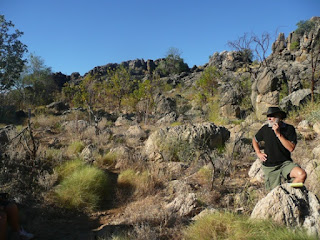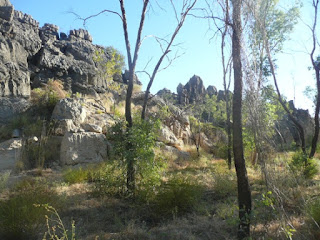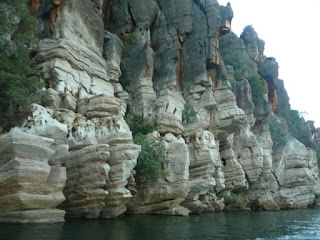We don't 'do tours' as a matter of course. We would rather get out there and sniff around ourselves after some serious pre-reading. But there are always times for the exception. The Willie Creek pearl farm excursion taught us that. And, as in that instance, there are some where a formal tour is the only way in which a place can be seen.
So it was with Geike Gorge, a section on the Fitzroy River quite close to Fitzroy Crossing much touted, vaunted and lauded in all of the tourist stuff we had read. We chose the 'sunset' option. What a good decision this proved to be.
As an added convenience, our tour left from the Lodge. Michael, the chap who had booked us in, also doubles as the guide. Our transport for the afternoon was beginning to show its age and the results of banging about on the local roads, but when it is someone else's vehicle rattling to death around me I could not be more relaxed.
Before heading out the 20 kms or so to the gorge, we were taken through and around the Fitzroy River township where Michael displayed an encyclopedic knowledge of the town's history and recent development. He later admitted that he is a statistics nut, and that was clearly demonstrated, but cleverly, he always wrapped the bare facts in interesting tales.
Our tour included a brief stop at the 'Pioneer Cemetary'. Surely that can't be it? Where are all the graves and headstones? It was here that I had my first introduction to the power of the Fitzroy River.
From this quaint memorial we were but a few metres from the river bank. And on this side it was a long way down to the water below. Annual flood erosion has been eating away at this bank for years. And guess where the original grave sites were?
The local authorities quite rightly decided that a river awash with the bones of the dearly departed and long lamented pioneers of the area would not be a good look, and had re-burial not taken place this is exactly what would have happened. The odd little memorial which make all this clear is all that remains on site. I did note that it was something which would be easy to relocate when the need inevitably arises, as it will...nothing can stop the Fitzroy.
Michael took this opportunity to emphasise just what a sleeping giant this river is during the dry. Here the bald stats were all that were needed (as detailed in my last). What a sight this must be during the wet. My fingers are continuing to hover over a new entry on the 'Bucket List'!
Our first glimpse of what we had come to see was not long in coming. This dark jumbled line
of rock suddenly appeared before us out of the surrounding plains. Unremarkable enough from this distance, but what a story there is here. These are interesting rocks indeed as we shall see.
Offloaded at the gorge tour visitor centre, our erudite host booked us all in

before we set off for the shorter of the two jaunts through the rock formations of the gorge.
Here we learnt all about it. We were looking at the remains of the seabed. These rocks are limestone, formed by the secretions of untold numbers of algae and other organisms during the Devonian period, a mere 400 million years or so ago.
These little builders of the prehistoric world laid down a reef of this material over 2 kilometres thick, and when the sea in which they swarmed receded and they all faded into obscurity, the legacy of their activity remains as a limestone range which now stands 100 metres above the plains and runs across the Kimberley for miles and miles.
As happens all over the world, where rivers and ranges clash, the rivers invariably win out, and so it is here at the Geike Gorge. Over the ages, the Fitzroy has carved a course over 30 metres deep though the primordial limestone with stunning results.

But we were not there just yet. Our walking trail took us through more of the rock formations where Michael again demonstrated the breadth of his local knowledge.
Even this distance away from the actual river bank, the spreading flood waters of the Fitzroy had carved away at the range over the eons.
And it has not only been the river waters which have shaped and scarred these soft rocks. Rainwater trickling down the face of some has dissolved them into odd and interesting shapes such as this 'elephant's trunk' (well, OK, just a little imagination is needed.... please.)
Some of the rock formations along this trail are impressive to say the least, but better was to come shortly.
After a fascinating and informative half an hour our so wandering amongst these monuments to this prehistoric endeavour, we made our collective way back to where the damp track underfoot suggested the river was close.

I don't like crowds, especially on a tour, but today I had no choice. As I had expected, there were several occasions when I was photographing the heads of fellow tourists as I struggled to gain a good shot. As a result I snapped away with more abandon than usual, and the resulting editorial effort to avoid boring you all to death, dear readers, yet still present what I hope is a balanced pictorial journey through the gorge, has been monumental.

The vista on either side was ever changing. Oddly balanced rocks
and basking 'freshies' were but part of the passing scenery.

Here the gorge wall shows the height to which the annual flood levels climb. The light colour of the limestone rock in its washed original state is in stark contrast to the weathered peaks high above the water line. In many spots the tops of the walls are jagged and sharp,
whilst here they present a more solid buttress.
In some spots the effects of the rushing water on the soft limestone has carved intricate patterns into the base of the gorge wall
whilst in other stretches trees have managed to take hold in the rock crevices and survive despite the annual assault by the floods.
This was a trip of ever changing views. On this side of the river gorge the battered walls rise sheer out of the river

whilst on the opposite bank, the dry season waters lap on sandbanks with the gorge walls quite some distance back. They were already beginning to change colour with the approach of sunset.
Geike Gorge is a truly stunning place, where the weathering of the gorge walls and the effects of the annual flood combine to produce constantly changing shapes and colours,
and some real oddities, like this outline of the unforgettable profile of 'Tricky Dicky', US President Richard Nixen of Watergate infamy.

It was time to be getting back. The sun was sinking rapidly. The trees along this section of the river bank were deep in shadow.

As we passed this idyllic little private landing, which reminded Liz and me so much of what we had often seen along the banks of the River Murray, we began to wonder if the skipper had left his run too late.

Our approach to the next bend showed that his timing was impeccable. The setting sun had just begun to paint the gorge walls.

And what a sight this was. As we moved further upstream more and more of the cliff face was being lit up.

Suddenly the tops of the gorge walls were glowing yellow and orange.
The dull colours of the day were being transformed before our eyes. This was real picture
postcard stuff and more than met our embarkation expectations. We could have sat here for hours but of course that would have been silly.

The sun was on the move and in a few minutes only the very tops of the rocks were catching the last rays.
What a magnificent spectacle we had enjoyed. I would have loved to have paddled this stretch of water on my kayak, which can be done with ranger permission, but time did not allow.The 'Bucket List' has another entry!

All that now remained was to tramp back to our rattling little tour bus and enjoy one last fling of the setting sun as we made our way back to camp through the twilight of what had been a wonderful day.
The Geike Gorge is the most accessible of many in this part of the Kimberley. All the others present the challenges of rutted access roads, dust and distance. The rewards are great, but for us, with limited time, no off road caravan capacity and my renowned aversion to dust, the Geike Gorge had more than met our desire to wonder at the way in which the mighty Fitzroy River has sculptured this part of the landscape. This had been a fittingly spectacular finale to our Fitzroy Crossing visit.




















No comments:
Post a Comment